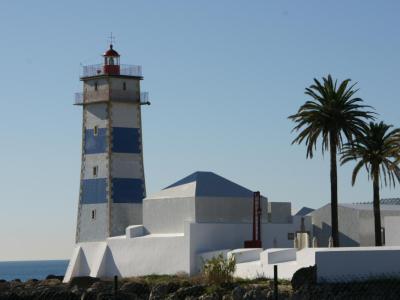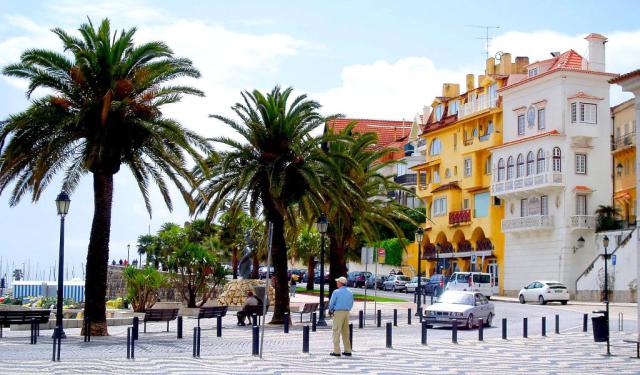Santa Marta Lighthouse, Cascais (must see)
The Santa Marta Lighthouse stands as a guardian over the estuary of the River Tagus. Its primary mission is to provide a guiding light for ships in the Cascais Bay and the town's modern marina. This lighthouse is a distinctive maritime landmark, instantly recognizable by its unique appearance.
The Santa Marta Lighthouse is constructed as a quadrangular tower, built with sturdy masonry and adorned with pristine white tiles. To make it even more visually striking, the tower features horizontal blue stripes that give it a distinct character. At its zenith, you'll find a vibrant red lantern that emits the crucial beacon of light, ensuring the safety of vessels navigating the waters in this region.
The history of the lighthouse is intimately intertwined with that of the Santa Marta Fort, on whose grounds it was erected. As the 20th century progressed, both the Santa Marta Fort and its accompanying lighthouse began to fall into disrepair. Recognizing the importance of preserving this significant cultural and maritime heritage, efforts were made to revitalize and restore the space. The fruits of these endeavors came to fruition in July 2007, with the reopening of the renovated fort and the inauguration of the Lighthouse Museum.
What sets the Santa Marta Lighthouse Museum apart is its unique combination of a functional working lighthouse alongside a comprehensive museum, a rarity in Portugal. Inside the museum, visitors can explore two distinct exhibition spaces, located within the former residences of the lighthouse keepers:
Room 1 - Portuguese Lighthouses: This section of the museum delves into the history of lighthouses in Portugal, offering insights into the technology and innovations that have been integral to maritime safety. Notable highlights include large Fresnel lenses, with a special focus on the optical apparatus of the Berlenga Lighthouse, an impressive 3.70 meters in height.
Room 2 - Santa Marta, from Fort to Lighthouse and The Craft of the Lighthouseman: Here, visitors can immerse themselves in the rich history of the Santa Marta Lighthouse, tracing its evolution over the years. The room showcases a lighthouse keeper's diary, providing meticulous records of foggy days and illuminated nights, giving a unique glimpse into the life of those who tended to the lighthouse.
Additionally, visitors have the opportunity to explore the fort's batteries, enjoying panoramic views of the sea and the picturesque Bay of Cascais.
The Santa Marta Lighthouse is constructed as a quadrangular tower, built with sturdy masonry and adorned with pristine white tiles. To make it even more visually striking, the tower features horizontal blue stripes that give it a distinct character. At its zenith, you'll find a vibrant red lantern that emits the crucial beacon of light, ensuring the safety of vessels navigating the waters in this region.
The history of the lighthouse is intimately intertwined with that of the Santa Marta Fort, on whose grounds it was erected. As the 20th century progressed, both the Santa Marta Fort and its accompanying lighthouse began to fall into disrepair. Recognizing the importance of preserving this significant cultural and maritime heritage, efforts were made to revitalize and restore the space. The fruits of these endeavors came to fruition in July 2007, with the reopening of the renovated fort and the inauguration of the Lighthouse Museum.
What sets the Santa Marta Lighthouse Museum apart is its unique combination of a functional working lighthouse alongside a comprehensive museum, a rarity in Portugal. Inside the museum, visitors can explore two distinct exhibition spaces, located within the former residences of the lighthouse keepers:
Room 1 - Portuguese Lighthouses: This section of the museum delves into the history of lighthouses in Portugal, offering insights into the technology and innovations that have been integral to maritime safety. Notable highlights include large Fresnel lenses, with a special focus on the optical apparatus of the Berlenga Lighthouse, an impressive 3.70 meters in height.
Room 2 - Santa Marta, from Fort to Lighthouse and The Craft of the Lighthouseman: Here, visitors can immerse themselves in the rich history of the Santa Marta Lighthouse, tracing its evolution over the years. The room showcases a lighthouse keeper's diary, providing meticulous records of foggy days and illuminated nights, giving a unique glimpse into the life of those who tended to the lighthouse.
Additionally, visitors have the opportunity to explore the fort's batteries, enjoying panoramic views of the sea and the picturesque Bay of Cascais.
Want to visit this sight? Check out these Self-Guided Walking Tours in Cascais. Alternatively, you can download the mobile app "GPSmyCity: Walks in 1K+ Cities" from Apple App Store or Google Play Store. The app turns your mobile device to a personal tour guide and it works offline, so no data plan is needed when traveling abroad.
Santa Marta Lighthouse on Map
Sight Name: Santa Marta Lighthouse
Sight Location: Cascais, Portugal (See walking tours in Cascais)
Sight Type: Museum/Gallery
Guide(s) Containing This Sight:
Sight Location: Cascais, Portugal (See walking tours in Cascais)
Sight Type: Museum/Gallery
Guide(s) Containing This Sight:
Walking Tours in Cascais, Portugal
Create Your Own Walk in Cascais
Creating your own self-guided walk in Cascais is easy and fun. Choose the city attractions that you want to see and a walk route map will be created just for you. You can even set your hotel as the start point of the walk.
Cascais Introduction Walking Tour
A charming seaside town some 30 minutes' drive away from the capital of Portugal, Cascais, holds a unique place in the country's history and culture. It started life as a humble fishing village, with the Romans, Visigoths, and Muslims leaving their mark on the area. Records dating back to Roman times suggest that it served as a stopover point for travelers along the coastline.
The... view more
Tour Duration: 2 Hour(s)
Travel Distance: 2.4 Km or 1.5 Miles
The... view more
Tour Duration: 2 Hour(s)
Travel Distance: 2.4 Km or 1.5 Miles




